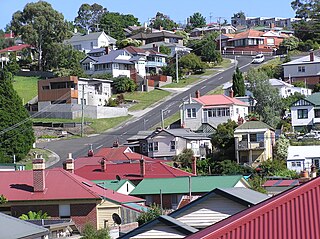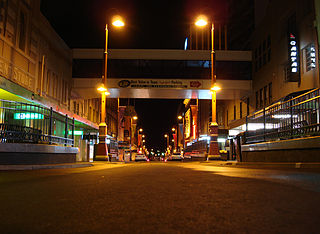
Hobart is the capital and most populous city of the Australian island state of Tasmania. Home to almost half of all Tasmanians, it is the least-populated Australian state capital city, and second-smallest if territories are taken into account, after Darwin, Northern Territory. Hobart is located in Tasmania's south-east on the estuary of the River Derwent, making it the most southern of Australia's capital cities. Its skyline is dominated by the 1,271-metre (4,170 ft) kunanyi/Mount Wellington, and its harbour forms the second-deepest natural port in the world, with much of the city's waterfront consisting of reclaimed land. The metropolitan area is often referred to as Greater Hobart, to differentiate it from the City of Hobart, one of the five local government areas that cover the city. It has a mild maritime climate.

Sullivans Cove is on the River Derwent adjacent to the Hobart CBD in Tasmania.

H.M. Gaol Hobart or Campbell Street Gaol, a former Australian maximum security prison for males and females, was located in Hobart, Tasmania. Built by convict labour, the gaol operated between 1821 until the early 1960s. In 1961, male inmates were transferred to the H.M. Risdon Prison and in 1963, female inmates were transferred to the Risdon Women's Prison.
Alexander William Campbell was the final surviving Australian participant of the Gallipoli campaign during the First World War. Campbell joined the Australian Army at the age of 16 in 1915, and served as a stores carrier for two months during the fighting at Gallipoli. He was invalided home and discharged in 1916. He later worked in large number of roles, was twice married and had nine children. He is the great-grandfather of actress, singer and model Ruby Rose.

Thomas Bock was an English-Australian artist and an early adopter of photography in Australia. Born in England he was sentenced to transportation in 1823. After gaining his freedom he set himself up as one of Australia's first professional artists and became well known for his portraits of colonists. As early as 1843 he began taking daguerreotypes in Hobart and became one of the earliest commercial photographers in Australia.

Blundstone Footwear is an Australian footwear brand, based in Hobart, Tasmania, with most manufacturing being done overseas since 2007. The company's best-known product is its line of laceless, elastic-sided, ankle-length boots. The official name for this product line is "The Original", although the boots are colloquially known as "Blunnies" in Australia.

Martin Cash was a notorious convict bushranger known for escaping twice from Port Arthur, Van Diemen's Land. His 1870 autobiography The Adventures of Martin Cash, ghostwritten by James Lester Burke, a former convict, became a best seller in Australia.

Elizabeth Street is the major street which runs southeast to northwest through the city and suburbs of Hobart, Tasmania, Australia. It was named by the Governor of New South Wales from 1810 to 1821, Lachlan Macquarie, after his wife Elizabeth Macquarie. It starts at Sullivans Cove and runs northwesterly through the CBD of Hobart and the North Hobart shopping district, and changes to become New Town Road at the intersection with Augusta Road in New Town.

Dynnyrne is a residential locality in the local government area (LGA) of Hobart in the Hobart LGA region of Tasmania. The locality is about 3 kilometres (1.9 mi) south-west of the town of Hobart. The 2016 census provides a population of 1577 for the state suburb of Dynnyrne.

West Hobart is an inner-city suburb of Hobart, Tasmania, Australia. It is in the hills immediately west of the city centre, and shares the postcode 7000 with that district.
John Lee Archer was the Civil Engineer and Colonial Architect in Van Diemen's Land, serving from 1827 to 1838. During his tenure, Archer was responsible for all Tasmanian government buildings including those for penal and military purposes.

Elizabeth Macquarie was the second wife of Lachlan Macquarie, who served as Governor of New South Wales from 1810 to 1821. She played a significant role in the establishment of the colony and is recognised in the naming of many Australian landmarks including Mrs Macquarie's Chair and Elizabeth Street, Hobart. Governor Macquarie named the town of Campbelltown, New South Wales after his wife's maiden name and a statue of her now stands in Mawson Park, Campbelltown.

Collins street is a one-way street in Hobart, Tasmania. The street was named after the founding Lieutenant Governor of the Colony of Van Diemens Land, David Collins.

Henry Hunter (1832–1892) was a prominent architect and civil servant in Tasmania and Queensland, Australia. He is best known for his work on churches. During his life was also at various times a state magistrate of Tasmania, a member of the Tasmanian State Board of Education, the Hobart Board of Health, a Commissioner for the New Norfolk Insane Asylum and President of the Queensland Institute of Architects.

Liverpool Street is a street in the Central Business District of Hobart, in the state of Tasmania.

Argyle Street is a street in Hobart, Tasmania. The street was named by Lachlan Macquarie either in reference to Argyll, Scotland, where he grew up, or for the Duke of Argyll, head of Clan Campbell. Lachlan's wife had been born Elizabeth Campbell.

Murray Street is street in Hobart, Tasmania. The street was named for Captain John Murray, commandant at Hobart Town, by Lachlan Macquarie.
Barrack Street is a street in Hobart, Tasmania. The Hobart Town military barracks were once located on this street.

Bathurst Street is a street in Hobart, Tasmania. The street was named by Lachlan Macquarie in honour of Henry Bathurst, 3rd Earl Bathurst.
Goulburn Street is a street in Hobart, Tasmania. The street was named after the first official Colonial Secretary of New South Wales, Frederick Goulburn, who arrived in Sydney in 1820.
















